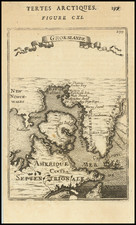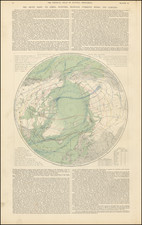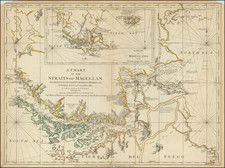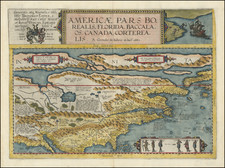Focusing on the Top of the World
Rare Ottens edition of Guillaume De L'Isle's fine map of the Northern Hemisphere, originally published by De L'Isle in 1714.
This edition includes improvements in the depiction of northeast Russia, the result of integration of the latest geographic information from the Bering expeditions.
The map centers on the North Pole and the continents seem to radiate out to the equator. The projection has the opposite effect of a Mercator projection, which tends to stretch and distort landmasses that are close to the poles. Here, it is territory close to the equator that is stretched, allowing the Arctic to come into sharp focus.
California is shown as a peninsula, although other contemporary maps still featured it as an island. Greenland is connected to Northern Canada in Baffin Bay, a common hypothesis at this time. Japan too is shown in what appears a rudimentary form; a more horizontal orientation of the archipelago was typical on maps until slightly later in the eighteenth century.
In the North Pacific, an unfinished island extends eastward. This Terre de la Compagnie is near Terre d’Yedso, an exaggeration of Hokkaido. Nearby, a note ties the former to the voyage of Dom Jean de Gama, who supposedly discovered a large coastline in the area. These chimeric shores shrank over the course of the century and eventually disappeared from maps.
Delineating the North Pacific: The Russians
The unfinished shores of North America and Greenland suggest that further exploration is necessary to better understand the Arctic. Indeed, the map seems to imply that there may be a navigable route north of Asia or around Baffin and Hudson’s Bay, a nod to the much-sought and still-elusive Northwest Passage.
One leader in the search for such a passage, and for a more detailed charting of northern waters, were the Russians. Two important expeditions, the first Russian naval expeditions focused minutely on geographic reconnaissance, helped to chart much of the Northeast Asian coast and proved that America and Asia were not connected. These voyages (1725-30, 1733-43), led by Vitus Bering, were only slowly integrated into European maps.
The text outside the hemisphere, in French and Dutch, explains how word of the expedition spread and made its way into maps like this. The text refers to a letter dated January 13, 1740 (with the additional date of January 24, a nod to the fact that certain countries had not shifted from the Julian to the Gregorian calendar). It was penned by a Monsieur Swartz residing in St. Petersburg.
A Covens & Mortier version of this map includes the text of the letter. Swartz, a Dutch diplomat, was reporting news from the second Bering expedition. He recounts a letter from Martin Spanberg, a Danish officer in the Russian navy, who had served on both expeditions. Spanberg recounted his recent discovery of 34 islands, which he supposed were part of Japan. The letter had been delivered with a coin, which had Chinese or Japanese characters on it.
The first Bering expedition also explains why Russia looks remarkably complete for the time. One of the sources for this and the Covens and Mortier versions of this map was the 1734 map of the Russian Empire by Ivan Kirilov. This map, which is rare, was part of Kirilov’s larger project, the Atlas Russicus, the first Russian atlas. Kirilov’s map was the first scientifically accurate map of Russia and one of the earliest to include the results of the initial Bering expedition. These results are seen here in the shape of the Kamchatka Peninsula and the northeastern-most parts of Asia.
One of the largest and best-organized voyages of exploration, the Great Northern Expedition completely remapped the Arctic coast of Siberia and some parts of the northwest coast of America. Vast amounts of hitherto unknown detail were filled in, which was previously represented following myth and speculation.
The idea of a land bridge from Siberia to America was long-held, appearing in maps since the fifteenth century and being the subject of academic speculation as to the origins of the indigenous peoples of America. To seek out the possibility of this land bridge, Peter the Great sent two unsuccessful land surveys to the area, before sending the First Kamatchka Expedition in 1725. This expedition made it slightly further than Cap Chutotsky and St. Lawrence island (now part of Alaska), and was celebrated as proving the absence of a land bridge between Russia and North America. This expedition made Bering, its commander, a national hero.
The logical next step was to try and reach North America. Empresses Anna and Elizabeth were both interested in continuing Peter the Great's legacy of exploration and sponsored a Second Kamatchka Expedition (1733-43). The expedition comprised of three separate groups; two divisions (one headed by Bering himself) crossed the Pacific, while an academic expedition explored Siberia. The academic interest in this expedition was great, and several leading scientists and geographers of the day were involved in its planning, including the cartographer Gerhard Müller.
This expeditions, later known as the Great Northern Expedition, filled in vast amounts of previously unknown coastal details. The important achievements of the second expedition included the European discovery of Alaska, the Aleutian Islands, the Commander Islands, Bering Island, as well as a detailed mapping of the northern and north-eastern coast of Russia and the Kuril Islands. The expedition also ended the myth of a massive landmass in the North Pacific. It would be this expedition that sparked the intriguing period of Russian settlement in North America.
North Pacific chimeras: Yesso, De Gama, and Compagnie Land
The etymology of the idiom Yesso (Eso, Yeco, Jesso, Yedso) is most likely the Japanese Ezo-chi; a term used for the lands north of the island of Honshu. During the Edō period (1600-1886), it came to represent the ‘foreigners’ on the Kuril and Sakhalin islands. As European traders came into contact with the Japanese in the seventeenth century, the term was transferred onto European maps, where it was often associated with the island of Hokkaido. It varies on maps from a small island to a near-continent sized mass that stretches from Asia to Alaska.
The toponym held interest for Europeans because the island was supposedly tied to mythic riches. Father Francis Xavier (1506-1552), an early Jesuit missionary to Japan and China, related stories that immense silver mines were to be found on a secluded Japanese island; these stories were echoed in Spanish reports. The rumors became so tenacious and tantalizing that Abraham Ortelius included an island of silver north of Japan on his 1589 map of the Pacific.
Yesso is often tied to two other mythical North Pacific lands, Gamaland and Compagnies Land. Juan de Gama, the grandson of Vasco de Gama, was a Portuguese navigator who was accused of illegal trading with the Spanish in the East Indies. Gama fled and sailed from Macau to Japan in the later sixteenth century. He then struck out east, across the Pacific, and supposedly saw lands in the North Pacific. These lands were initially shown as small islands on Portuguese charts, but ballooned into a continent-sized landmass in later representations.
Several voyagers sought out these chimerical islands, including the Dutchmen Matthijs Hendrickszoon Quast in 1639 and Maarten Gerritszoon Vries in 1643. Compagnies Land, often shown along with Staten Land, were islands sighted by Vries on his 1643 voyage. He named the islands for the Dutch States General (Staten Land) and for the Dutch East India Company (VOC) (Compagnies, or Company’s Land). In reality, he had re-discovered two of the Kuril Islands. However, other mapmakers latched onto Compagnies Land in particular, enlarging and merging it with Yesso and/or Gamaland.
In the mid-eighteenth century, Vitus Bering, a Danish explorer in Russian employ, and later James Cook would both check the area and find nothing. La Perouse also sought the huge islands, but found only the Kurils, putting to rest the myth of the continent-sized dream lands.
The Ottens brothers, Reiner and Joshua, operated a successful printing partnership in the mid-eighteenth century (fl. 1726-1765). They began the venture in 1726, publishing maps and other prints as “R & I Ottens.” They specialized in the reprinting of others’ work, especially Guillaume De L’Isle. In 1750, Reiner died; his soon, also Reiner, took his place, but the firm began listing their works as “Joshua & Reiner Ottens.” The firm lasted until Joshua’s death in 1765. Joshua’s widow, Johanna de Lindt, sold their remaining stock of plates in 1784.









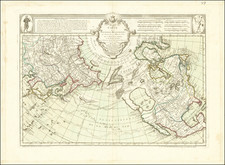
![[Grotto of Tethys -- Versailles] Le Soleil qui se couche dans la mer / Le Globe de la Terre, divise en six parties.](https://storage.googleapis.com/raremaps/img/small/79606.jpg)
